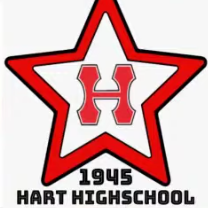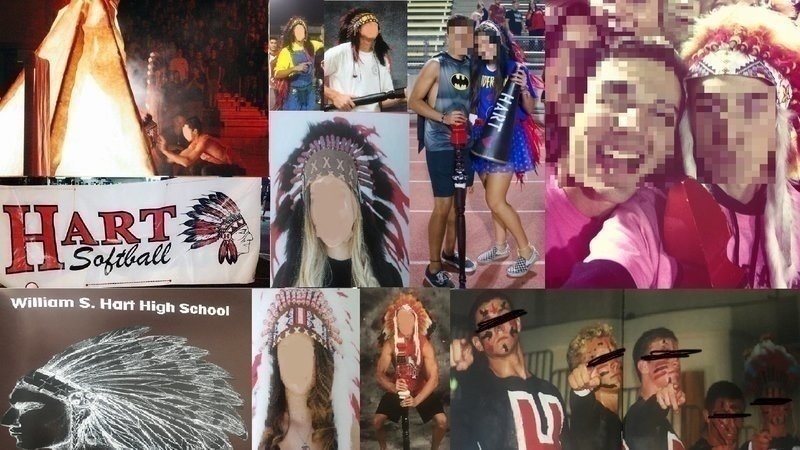Retiring Hart High’s Race-Based Mascot: What Culture Will We Allow?
An editorial from The Daily Howl editorial board
March 17, 2021
The William S. Hart School District Board is considering whether to change the Hart High School race-based mascot, the Indian. A petition to retire the Hart mascot first circulated in June of 2020. Started by recent Hart graduate, Grace Gooneratne, working alongside Julia Estrada and Kathryn Supple, the petition quickly gained over 18,000 signatures and drew the attention of the school board. On Feb. 9, the board conducted a study-session concerning retiring the mascot in order to listen and learn more about the issue. The board invited the local tribe leader, Rudy Ortega Jr., to speak at the meeting on Feb. 18. No decision has been made about the Hart High School mascot as the discussions are ongoing. It is the decision of the editorial board of The Daily Howl to speak on this monumental issue in our community.
The Daily Howl editorial board stands in solidarity with and in support of the Fernandeño Tataviam Band of Mission Indians and the movement to retire the Hart High School race-based mascot, the Indian.
Rudy Ortega Jr., Tribal President of the Fernandeño Tataviam Band of Mission Indians or the FTBMI, spoke to the Hart Board about the history of the Indigenous people in America and his tribe’s views on race-based mascots during his presentation at the board meeting on Feb. 18. Ortega outlined how Indigenous people were “the first people to this continent and we’re the last people to be given the rights” that early immigrants to America had, like freedom of religion and the right to vote. Ortega also explained how his ancestors became refugees in their homeland and were forced to erase their own culture. Even now, Ortega told the board that the FTBMI is currently trying to revitalize their spoken language, much of which has been lost along with many elements of their culture and traditions.
The voice of the local tribe remains the most important opinion when it comes to the decision of retiring the Hart mascot. As this issue directly relates to them and their history, the decision should lie with the FTBMI. However, in this case, the school board retains the power, and thus far they have said the decision should include input from the greater community, so everyone should make an effort to listen to the opinion of the local tribe.
During the meeting, Ortega shared that the FTBMI and the majority of the tribes across California are in support of replacing race-based mascots. On the Fernandeño Tataviam Band of Mission Indians website, they have published a public statement further denouncing race-based mascots. It states, “The Fernandeño Tataviam Band of Mission Indians (FTBMI or Tribe) supports the removal, retirement, and replacement of race-based mascots, symbols, and images and personality by schools, colleges, universities, athletic teams, and organizations.” This opinion is also shared by the National Congress of American Indians, or the NCAI, “which is the most representative group of Native Americans [as] they have fifty plus tribes represented in their council,” says Julia Estrada, one of the Hart High School alumna involved in the campaign to retire the mascot.
Estrada worked with Gooneratne and Supple to make sure the petition to retire the Hart mascot and the greater campaign gained traction. Due to the group’s hard work and outreach, “the Indigenous People’s Movement, the National Congress of American Indians, and the Fernandeño Tataviam Band of Mission Indians all expressed support for the retirement and replacement of Hart High School’s mascot,” says Estrada when The Daily Howl editorial board reached out for a comment. According to Estrada, the group has been in conversation with the school board since June 2020. Since then, they have met with the school board and members of the FTBMI via Zoom, attended a tour of Hart to discuss the mascot with the FBMI, attended another tour, this time at the FTBMI headquarters, and done many interviews on multiple local news outlets. This all took place before Estrada’s presentation, which she delivered to the board on Feb. 9.
“We ask the community members to recognize that this mascot is not an honor,” says Estrada. She explained in her presentation, “in order for something to be named an honor the sentiment needs to be accepted by the honoree” and neither FTBMI nor NCAI believe the Indian mascot is an honor. During her presentation, Estrada also outlined her experience with students who had worn headdresses, used battle cries, and chanted stereotypical Indian calls during her tennis matches. “As a Native American…that was extremely uncomfortable given that my family would be there,” says Estrada, who also mentioned how she discussed the inappropriate nature of these actions with many students who partook in them. In order for the students to understand why these actions were harmful, “all it really took was a thoughtful and engaging discussion.”
A mascot inherently objectifies and dehumanizes whatever may be the mascot, and in this case, ultimately supports a culture of ignorance, disrespect, and inappropriate behavior towards Native Americans. In the statement the FTBMI released on their website in support of retiring race-based mascots they write, “It is demeaning to depict us—the First People of northern Los Angeles County—as mascots because it does not honor our history, ancestors, or culture. Rather, it perpetuates dehumanizing and harmful stereotypes about Native Americans and promotes over-generalizations about a culturally diverse and unique peoples.”
The statement goes on to say, “Tribal citizens have vocalized their fear for their children who may attend these schools where race-based chants, symbols, make-up, costumes, and/or atmosphere will impact their Native student’s self-esteem and self-worth.” Research supports the tribal citizens’ fears. As Estrada outlined in her presentation, a study conducted by the University of California, Berkeley found that the more a student identifies with being Native American, the more harm race-based mascots like Indians can cause.
By retiring the Hart mascot the high school can “create a more inclusive environment for incoming students” by making it “clear that [these] conversations with our local tribe are part of a sincere effort to listen to Native voices,” says Estrada in her communications with the editorial board. Hart High School, the Hart School Board, and the community should take into consideration that supporting the change of race-based Native American mascots is a “true gesture toward equality and justice that centers our children and future generations,” as the FTBMI wrote on their website. The Native American students attending Hart “should feel proud of their heritage, culture, and who they are as native people,” says Ortega at the Feb. 18 board meeting.
One concern of the opposing side, expressed by board member Joe Messina, is that this venture is a slippery slope as the question arises of “should we now look at the vikings, centurions, cowboys, [and] conquistadors?” Are these other mascots in the district on the chopping block just as the Indians are? Are these mascots even comparable? The answer is no. No, they are not.
A local newspaper in Iowa eloquently points out the difference between mascots like braves or Indians from those like Vikings or centurions in an issue of The Gazette. Sam Aden writes, “What they don’t understand is that neither cowboys nor Vikings nor any other team mascot were ever the target of genocide, government persecution or race-based debasement. Nor have cowboys, Vikings or any other mascot-related group been demonized as uncivilized savages.” Aden points out the undeniable truth, that indigenous peoples’ history in America separates them from other groups. Assuming that the horrific history of Native Americans does not play a major role in the controversy surrounding these race-based mascots is ignorant.
Jason d’Autremont and Larry Strausse, the current and past principals of Hart High School, respectively, shared some history on the work that has been done to increase education and combat harmful interpretation of the mascot that leads to inappropriate behavior among the student body. During Strausse’s time as principal of Hart in the ‘90s, a conversation was held with the local tribes leading to changes on campus. This included retiring the fight song and chants that depicted Native Americans in a harmful or stereotypical way, the retirement of headdresses worn by staff and students, implementation of further education about Native American history, and the removal of illustrations of Native Americans included in the Hart High School seal. However, d’Autremont pointed out that only the last change, concerning the depiction of the mascot, remained consistent at Hart.
D’Autremont did address the Hart student body in Oct. 2020 on the morning announcements, prohibiting these actions once more. Although, if the changes that were made in the ’90s were not sustained by Hart High School, who is to say further sensitivity and education on the part of the high school will be permanently implemented? Estrada pointed out that it is important for “the Hart School Board to recognize that this mascot has been problematic for decades, and no matter how many times the school has “phased away” from it, the offensive traditions will always find their way back so long as the mascot remains an ‘Indian.’”
The strides Hart High School has made in the past are significant and important, but they have deteriorated over time. In the ‘90s, Hart took steps in the right direction, so “it makes even more sense now to take the final step and fully commit to the changing and retirement of our mascot,” Estrada told the board on Feb. 9. The board stated during the meeting that they would like to consider views from members of the community, particularly students, and especially those at Hart High School. If you want the board to hear your opinion be sure to submit a letter.



Many students from Hart High School have already shown their support for retiring the mascot through signing the growing petition, and also by submitting mock-ups of new designs for a new mascot. These drawings include bison, rattlers/rattlesnakes, mustangs, and hawks, all of which are appropriate mascots to rally around. Estrada told the editorial board that “these submissions indicate that this discussion has inspired some Hart students and sparked creativity. Hart High students have great school spirit; therefore, a mascot change would simply encourage the student body to use the change as an opportunity to create new traditions and make new memories of their time at Hart.”
Students rallying around these types of mascots would not perpetuate appropriation of culture, stereotyping of Indigenous people, or acting inappropriately or insensitively as race-based mascots do. Retiring the Hart High School Indian mascot “would positively change the culture of Hart High School,” Estrada told the editorial board of the paper. Choosing a new mascot is an opportunity for a new culture, designed by the students at Hart; one they have already shown excitement for through these mascot mock-ups.
During the board meeting, the board members mentioned the process Castaic High School went through to select the colors and mascot for the school. For Castaic, the board let the high school and community decide on the coyote mascot and provided a ‘blessing’ once the decision was made. The inaugural class was a part of the discussions about the mascot for which crabs, dolphins, caterpillars, and other animals were discussed among the prospective student body. Never was a race-based mascot ever in consideration among the students as an ideal mascot for the school. That idea seems outdated, insensitive, and overall inappropriate in this day and age.
According to the New York Times, the National Congress of American Indians (NCAI) database shows that 29 schools have abandoned race-based mascots, including 11 schools with Indians as their mascot, within the past six months. Race-based mascots are no longer accepted by society and that is evident through the changes being made across the U.S. and also by the choices the local community has already made.
If choosing a race-based mascot was not a choice the community would make now, then why is the Indian still Hart High School’s mascot? “Keeping a race-based mascot sends a clear message,” as written on the FTBMI website, “that a school district values their school pride based upon race-based imagery more than the harmful psychological and emotional impacts it has on real-life Native students.” This is not the reputation Hart High School or William S. Hart School District should have because this community values the Native American population and their opinions. If the Hart High School Indian mascot is retired it would show that the high school, school board, and the community “is making a sincere effort to listen to native voices and promote inclusivity,” Estrada says.
The Indian mascot will forever be the first mascot of Hart High School, but that does not mean it has to remain the mascot. Hart is not indefinitely bound to the poor decisions made in the past purely for the sake of history. Even if a new mascot is chosen, Estrada explained to the board that “history cannot be erased.” Rather, the retirement of the Indian mascot creates an “opportunity to make new history.”
By creating a new history the community has the opportunity to establish a culture that promotes understanding. The current principal of Hart High School, Mr. d’Autremont, concluded his presentation by saying, “our culture is what we allow.”
Now the question our community is faced with is, what culture will we allow? One bound indefinitely to the past? Or a different one, paving the way to a new future? Let us be on the side that will allow future students to be proud of their history.




Zo • Jun 13, 2023 at 1:28 am
Just found this article randomly googling this one slaps
Ranjani • Apr 12, 2022 at 10:46 am
Good job . I love your article!
Julie Hannant • Apr 12, 2022 at 10:38 am
Great report Ava! Young people today are so inspiring.
K McCurdy • Apr 12, 2022 at 9:43 am
Very insightful and well presented. It’s a mark of maturity and growth, respect and consideration to change a race based mascot. Cheers! Great to see straight-forward and respectful reporting in young people. I hope the reporter goes on to great things.
Jennifer Grace • Apr 12, 2022 at 8:54 am
Well done! Thank you for your bravery and for using your journalism skills to help make this a better world.